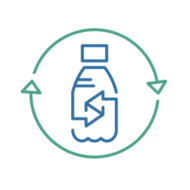You’ve probably fallen for one of these tricks…
Greenwashing – disinformation disseminated by an organization so as to present an environmentally responsible public image.
There are a lot of sneaky marketing tactics out there these days. Brands know if they are just a little bit greener than their competition that might be the edge they need to win your business. Sometimes that means adding a random green leaf on their packaging, repping that oh-so-popular all natural stamp, and even posting down right false claims.
Make sure you’re not being tricked into supporting a company that doesn’t actually meet your values. Here are some tips to help you recognize greenwashing so you can support the companies that are truly making progress.
Common Greenwashing Techniques:
1. Fluffy language
You have to be careful with the way you interpret marketing language. The important thing to remember is that you can’t take labels and their messaging for face value. Check to see if their claims are backed up or are just plastered across the label.
“All Natural” is one of the biggest claims that has pretty much no significance. The definition is vague and the term has been used so much it’s watered down. Wording can also be tricky. Cage free is way different from free range. In order to be assured, you need to look for third party certifications (more on this below).
2. Misleading pictures
Watch out for green symbols that have no real meaning, green packaging, flowers, rainbows, and unicorns. Brands will put just about anything on their product labels if they think it will increase sales. They may make you feel good at first sight, but you have to ask yourself “Is this really significant?”.
3. Vague Claims
Many brands will claim their products contain a certain amount of recycled material or they reclaim a certain number of their bottle caps each year. It’s very common for a company to dig up a nice looking statistic and use it for marketing, but more often then not, they have way more ugly stats they aren’t sharing…
Claims will often be broad and vague. Here are a few to watch out for:
- “free of”
- “non-toxic”
- “less of”
- “made from”
- more detail about green claims
Just being aware of this tactic makes you way less likely to fall for it. Keep your eye out for these!
4. The Big Picture
Many companies will say their product saves a lot of water or that they have reduced their carbon footprint. They may have reduced their water usage or green house gas emissions but if they went from horrendous levels down to extremely bad levels, that doesn’t mean much. They may also have other huge impacts they aren’t bragging about like unfair labor conditions for their workers or chemical pollution from their factories.
It’s easy to take claims for face value, but if you really want to make an impact with your purchasing you need to make sure you get a clear representation of a company. Are they really trying to make a difference or did they just drum up a few lines to make more sales?
Here are a few things you can look for that show a brand is taking steps in the right direction:
Real Eco-Labels
USDA Organic, Fair Trade, Non-GMO Project Verified, Leaping Bunny, Energy Star… these are some of the most well known, but there are over 450! Products and companies have to be certified by a third party to be able to sport their eco-label so you know they’ve been vetted if they have one. Get to know the eco-labels for product categories so you know what to look for.
Shop Local
Usually locally-produced products that are made on a small scale are a better option. Small local businesses can’t compete on price because they don’t have the resources big corporations do. Instead they compete on quality. Local businesses have embraced the shop local movement and are likely to let you know they are local on their packaging. The price may be a bit higher, but you’re paying for higher quality and the peace of mind that you’re considerably decreasing your impact.
Look Deeper
Make a more thorough investigation of the product. If you’re buying food, read the ingredients. Are the ingredients simple and recognizable or does it look like a bunch of compounds made in a lab?
If you’re buying a product, take a deeper look at it. See if you can find out where it was made and what the materials are. Asking yourself a few basic questions can help you get a clearer understanding of the product in question. You can also use an app like GoodGuide to get an idea for the product’s health, social, and environmental standing.
By simply being able to recognize these greenwashing tactics you’re taking a big step toward being more conscious. Feel free to share your tips for shopping responsibly in the comments section!
If you found this article helpful and you want to get the occasional tip to help you stay up on environmental and social responsibility, you can join the team by signing up below.
[yikes-mailchimp form=”2″]






